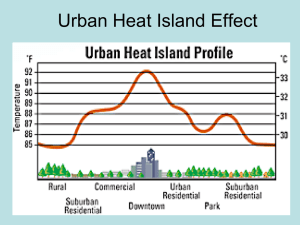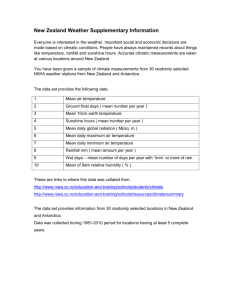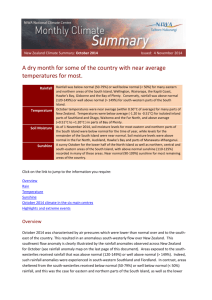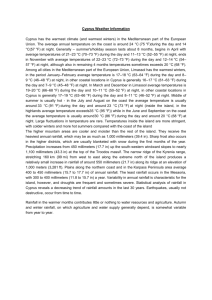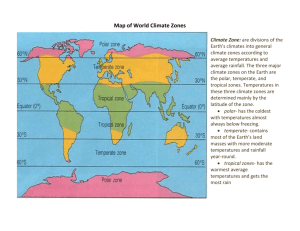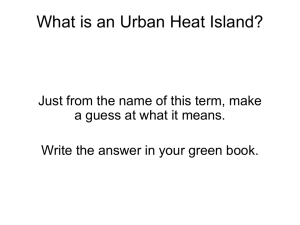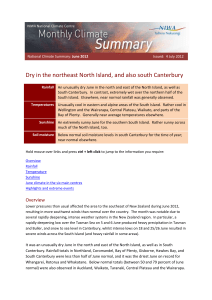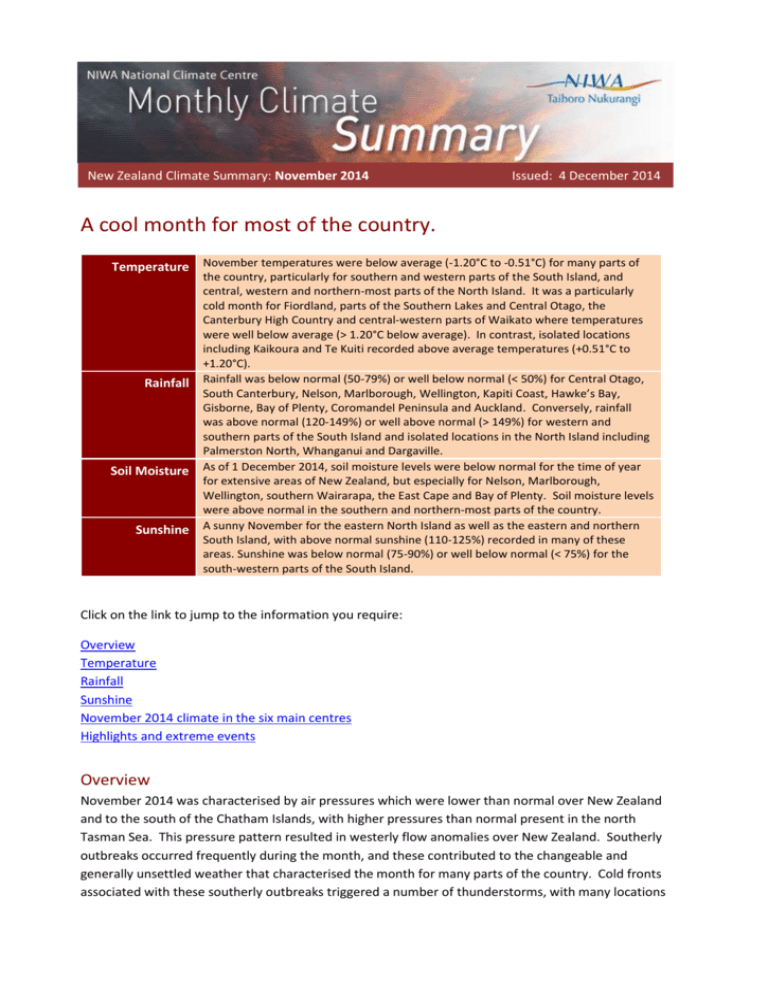
New Zealand Climate Summary: November 2014
Issued: 4 December 2014
A cool month for most of the country.
Temperature November temperatures were below average (-1.20°C to -0.51°C) for many parts of
Rainfall
Soil Moisture
Sunshine
the country, particularly for southern and western parts of the South Island, and
central, western and northern-most parts of the North Island. It was a particularly
cold month for Fiordland, parts of the Southern Lakes and Central Otago, the
Canterbury High Country and central-western parts of Waikato where temperatures
were well below average (> 1.20°C below average). In contrast, isolated locations
including Kaikoura and Te Kuiti recorded above average temperatures (+0.51°C to
+1.20°C).
Rainfall was below normal (50-79%) or well below normal (< 50%) for Central Otago,
South Canterbury, Nelson, Marlborough, Wellington, Kapiti Coast, Hawke’s Bay,
Gisborne, Bay of Plenty, Coromandel Peninsula and Auckland. Conversely, rainfall
was above normal (120-149%) or well above normal (> 149%) for western and
southern parts of the South Island and isolated locations in the North Island including
Palmerston North, Whanganui and Dargaville.
As of 1 December 2014, soil moisture levels were below normal for the time of year
for extensive areas of New Zealand, but especially for Nelson, Marlborough,
Wellington, southern Wairarapa, the East Cape and Bay of Plenty. Soil moisture levels
were above normal in the southern and northern-most parts of the country.
A sunny November for the eastern North Island as well as the eastern and northern
South Island, with above normal sunshine (110-125%) recorded in many of these
areas. Sunshine was below normal (75-90%) or well below normal (< 75%) for the
south-western parts of the South Island.
Click on the link to jump to the information you require:
Overview
Temperature
Rainfall
Sunshine
November 2014 climate in the six main centres
Highlights and extreme events
Overview
November 2014 was characterised by air pressures which were lower than normal over New Zealand
and to the south of the Chatham Islands, with higher pressures than normal present in the north
Tasman Sea. This pressure pattern resulted in westerly flow anomalies over New Zealand. Southerly
outbreaks occurred frequently during the month, and these contributed to the changeable and
generally unsettled weather that characterised the month for many parts of the country. Cold fronts
associated with these southerly outbreaks triggered a number of thunderstorms, with many locations
observing lightning and hail at least once during the month (see Highlights and extreme events section
for further details). The high frequency of southerly outbreaks were reflected in temperatures for the
month as a whole, which were below average (-1.20°C to -0.51°C) for southern and western parts of
the South Island, and central, western and northern-most parts of the North Island. November
temperatures were particularly low for Fiordland, parts of the Southern Lakes and Central Otago, the
Canterbury High Country and central-western parts of Waikato where temperatures were well below
average (> 1.20°C below average). Despite the generally cool conditions overall, warm periods
occurred when westerly flows became established, enabling the foehn effect to increase temperatures
in eastern parts of both islands. This was especially notable during the last ten days of the month,
when daily maximum air temperatures frequently reached the mid-20’s and beyond in Christchurch,
Blenheim, Napier and Gisborne. The nation-wide average temperature in November 2014 was 13.4°C
(0.3°C below the 1971-2000 November average from NIWA’s seven station temperature series which
begins in 1909)1.
The westerly flow anomaly for the month as a whole contributed to rainfall totals that were above
normal (120-149%) or well above normal (> 149%) for western and southern parts of the South Island,
and isolated locations in the North Island including Palmerston North, Whanganui and Dargaville. The
orographic effect of air moving eastwards over elevated land meant that rainfall was below normal
(50-79%) or well below normal (< 50%) in eastern parts of both islands such as Central Otago, South
Canterbury, Marlborough, Hawke’s Bay, Gisborne, Bay of Plenty and the Coromandel Peninsula. It was
a similarly dry month for Nelson, Wellington, the Kapiti Coast and Auckland. Remaining areas of the
country typically received near normal rainfall (within 20% of normal) for the month.
As of 1 December 2014, soil moisture levels throughout New Zealand were closely reflective of the
rainfall anomalies observed during November. Soils had dried considerably for many areas of the
North Island in comparison to the soil moisture levels observed on 1 November. Specifically, soils had
become notably drier than normal for Wellington, southern Wairarapa, Hawke’s Bay, Gisborne and Bay
of Plenty. In the South Island, soils around the Nelson region had become considerably drier than
normal for the time of year, whilst soils on the east coast of the South Island remained drier than
normal. In contrast, soils were wetter than normal for the south of the South Island on the back of an
especially wet November. Soil moisture levels were largely near normal for remaining parts of New
Zealand.
Most of the country received near normal (90-109%) or above normal (110-125%) sunshine hours for
November. It was particularly sunny for eastern areas of the North Island, and eastern and northern
parts of the South Island, with well above normal sunshine (> 125%) observed in Gisborne, Blenheim
and Cheviot. In contrast, it was a cloudy month for south-western parts of the South Island, where
sunshine was below normal (75-90%) or well below normal (< 75%) for the south-western parts of the
South Island.
Further Highlights:
1
The highest temperature was 31.1°C, observed at Christchurch (Riccarton) on 22 November.
The lowest temperature was -3.4°C, observed at Middlemarch on 11 November.
Interim value
The highest 1-day rainfall was 226 mm, recorded at Milford Sound on 21 November.
The highest wind gust was 209 km/hr, observed at Cape Turnagain on 18 November.
Of the six main centres in November 2014, Auckland was the warmest, Dunedin was the
coolest, Tauranga was the driest, Hamilton was the wettest and cloudiest and Christchurch
was the sunniest.
Of the available, regularly reporting sunshine observation sites, the sunniest four centres2 so
far in 2014 (1 January to 30 November) are: Whakatane (2477 hours), Blenheim (2289 hours),
Nelson (2283 hours) and Lake Tekapo (2255 hours).
For further information, please contact:
Mr Chris Brandolino
NIWA Forecaster – NIWA National Climate Centre
Tel. 09 375 6335, Mobile (027) 886 0014
Temperature: Below average for many parts of the country
November as a whole was a cool month across much of New Zealand, but not excessively cold. This is
reflected in relatively few locations observing record high or low mean temperatures for the month.
Perhaps most notable this month was Masterton (14.9°C) observing a higher mean temperature for
the month than Kaitaia (14.1°C): a quite uncommon occurrence. It is likely that the relative warmth
experienced in Masterton resulted from the foehn effect of the anomalous westerly flow during the
month. A number of southern locations observed near-record low mean maximum air temperatures,
which is likely to be a reflection of the cloudy and wet conditions that prevailed during November
there. The nation-wide average temperature in November 2014 was 13.4°C (0.3°C below the 19712000 November average from NIWA’s seven station temperature series which begins in 1909).
Record3 or near-record mean air temperatures for November were recorded at:
Location
High records or near-records
Masterton
Low records or near-records
Kaitaia
Te Kuiti
Secretary Island
South West Cape
Taumarunui
Tiwai Point
2
Mean
air temp. (oC)
Departure from
normal (oC)
Year records
began
Comments
14.9
1.0
1992
3rd-highest
14.1
11.9
10.7
9.4
12.6
10.5
-1.8
-2.9
-1.2
-1.2
-1.7
-1.3
1967
1959
1985
1991
1947
1970
Lowest
Lowest
3rd-lowest
3rd-lowest
4th-lowest
4th-lowest
New Plymouth sunshine is still omitted from this ranking while recent instrumentation changes are assessed.
The rankings (1st, 2nd, 3rd.etc) in all Tables in this summary are relative to climate data from a group of nearby
stations, some of which may no longer be operating. The current climate value is compared against all values
from any member of the group, without any regard for homogeneity between one station’s record, and another.
This approach is used due to the practical limitations of performing homogeneity checks in real-time.
3
Record or near-record mean maximum air temperatures for November were recorded at:
Location
Mean maximum
air temp. (oC)
High records or near-records
Mahia
Low records or near-records
Te Kuiti
Kaitaia
Port Taharoa
Secretary Island
South West Cape
Manapouri
Lumsden
Balclutha
Departure from
normal (oC)
Year records
began
Comments
18.9
0.7
1990
4th-highest
17.2
17.8
17.7
13.4
11.8
14.7
15.5
15.3
-2.8
-1.9
-1.3
-1.6
-1.8
-2.0
-1.4
-1.9
1959
1967
1973
1985
1991
1963
1982
1964
Lowest
2nd-lowest
2nd-lowest
2nd-lowest
3rd-lowest
4th-lowest
4th-lowest
4th-lowest
Record or near-record mean minimum air temperatures for November were recorded at:
Location
High records or near-records
Masterton
Campbell Island
Low records or near-records
Te Kuiti
Whangaparaoa
Taumarunui
Tiwai Point
Motueka
Winchmore
Kaitaia
Motu
Wairoa
Appleby
Mt Cook Village
Mean minimum
air temp. (oC)
Departure from
normal (oC)
Year records
began
Comments
9.3
5.4
1.5
0.9
1992
1991
3rd-highest
3rd-highest
6.6
11.2
7.0
6.8
6.7
5.1
10.4
6.0
9.1
6.4
2.9
-2.9
-1.4
-1.9
-1.6
-2.0
-2.2
-1.6
-1.4
-1.4
-2.6
-2.5
1959
1982
1947
1970
1956
1928
1967
1990
1964
1932
1929
Lowest
2nd-lowest
2nd-lowest
2nd-lowest
3rd-lowest
3rd-lowest
4th-lowest
4th-lowest
4th-lowest
4th-lowest
4th-lowest
Rainfall: Wet for the south of the South Island
November was a particularly wet month for southern parts of the South Island, where double the
normal November rainfall was recorded. Invercargill observed its third-wettest November on record;
remarkably, rainfall was recorded on all but four days of the month there. It was also a wet month in
Milford Sound, which recorded approximately 1000 mm of rainfall (nearly 200% of normal). In
contrast, it was especially dry in Nelson where just 13% of normal rainfall was received.
Record or near-record November rainfall totals were recorded at:
Location
Rainfall
total (mm)
High records or near-records
Tiwai Point
Balclutha
Secretary Island
Invercargill
Nugget Point
South West Cape
Low records or near-records
Mahia
Wairoa
Nelson
Percentage
of normal
Year
records
began
Comments
179
100
531
181
132
139
205
196
150
200
201
128
1970
1964
1985
1900
1930
1991
Highest
2nd-highest
3rd-highest
3rd-highest
3rd-highest
4th-highest
17
23
10
22
30
13
1990
1964
1941
2nd-lowest
3rd-lowest
3rd-lowest
Sunshine: A sunny month for eastern parts
November was a sunny month for eastern parts of both islands. Cheviot observed its highest total
sunshine hours for November on record, coming on the back of the town observing its third-highest
total sunshine hours for October on record. It was an especially gloomy month in Queenstown, which
recorded just 57% of its normal November sunshine: the lowest in records which began in 1930. A
relatively cloudy month for Lake Tekapo compared to other sunny spots meant it slipped from second
position to fourth in the rankings of New Zealand’s sunniest centres in 2014. Of the available, regularly
reporting sunshine observation sites, the sunniest four centres so far in 2014 (1 January to 30
November) are: Whakatane (2477 hours), Blenheim (2289 hours), Nelson (2283 hours) and Lake
Tekapo (2255 hours).
Record or near-record November sunshine hours were recorded at:
Location
High records or near-records
Cheviot
Blenheim
Gisborne
Low records or near-records
Queenstown
Invercargill
Sunshine
hours
Percentage
of normal
Year records
began
Comments
266
292
285
139
125
131
1983
1947
1905
Highest
2nd-highest
3rd-highest
124
130
57
72
1930
1913
Lowest
4th-lowest
November climate in the six main centres
November temperatures were well below average in Hamilton and below average in Dunedin, but
near average in the remaining four main centres. It was a dry month in Tauranga and Wellington,
which received just 47% and 52% of normal November rainfall respectively. Whilst it was both colder
and wetter than normal in Dunedin, the city did at least enjoy above normal sunshine hours. Sunshine
was similarly above normal in Auckland, Wellington and Christchurch. Of the six main centres in
November 2014, Auckland was the warmest, Dunedin was the coolest, Tauranga was the driest,
Hamilton was the wettest and cloudiest and Christchurch was the sunniest.
November 2014 main centre climate statistics:
Temperature
Location
Mean temp. (oC)
Departure from
normal (oC)
Aucklanda
16.0
-0.1
Near average
Taurangab
15.8
-0.1
Near average
13.5
-1.2
Well below average
13.6
+0.2
Near average
Christchurche
13.5
0.0
Near average
Dunedinf
11.5
-0.9
Below average
Rainfall (mm)
% of normal
Aucklanda
47
72%
Below normal
b
35
47%
Well below normal
Hamiltonc
82
92%
Near normal
51
52%
Below normal
48
104%
Near normal
74
131%
Above normal
Location
Sunshine (hours)
% of normal
Aucklanda
216
112%
Above normal
Taurangab
235
105%
Near normal
g
176
93%
Near normal
Wellingtond
242
116%
Above normal
Christchurche
254
113%
Above normal
117%
Above normal
Hamiltonc
Wellington
d
Comments
Rainfall
Location
Tauranga
Wellingtond
Christchurch
e
Dunedinf
Comments
Sunshine
Hamilton
Dunedinf
a
Mangere
195
b
Tauranga Airport
c
Hamilton Airport
d
Kelburn
e
Comments
Christchurch Airport
f
Musselburgh g Ruakura
Highlights and extreme events
Temperatures
On 1 and 2 November a strong northwest airflow brought high temperatures to many parts of the
country. Temperatures were especially high for the time of year on 2 November, when the maximum
temperature reached 28.4°C in Timaru, 27.9°C in Napier, 27.8°C in Gisborne, 27.2°C in Clyde and
24.9°C in Dunedin. Also notable were some very high overnight temperatures recorded on the night of
1 November. Between 6 p.m. on 1 November and 8 a.m. on 2 November, the temperature never
dropped below 18.2°C in Balclutha, 19.2°C in Clyde and 20.7°C in Dunedin. In addition, Lumsden
(16.1°C) observed its highest daily minimum temperature on record for the month of November (see
table below).
On 5 November, cold southerlies contributed to a winter-like day along the east coast of the South
Island. Air temperatures dipped as low as 6.8°C in Christchurch and 4.3°C in Winchmore (near
Ashburton) in mid-afternoon with heavy showers passing through frequently.
On 13 November Milford Sound recorded a maximum temperature of 19.9°C, the highest maximum
temperature of the day across all of New Zealand. The southerly airflow resulted in a cool day
throughout the country, with the exception of Milford Sound which benefitted from the foehn effect
of the southerly winds passing over the western ranges.
At 10.45 a.m. on 15 November it was 26.2°C in Napier but just 6.2°C in Invercargill. This illustrated the
considerable difference in temperature of the airmass in the pre-cold front north-westerly winds over
Napier and the post-front south-westerlies in Invercargill.
On 22 November warm north-westerly winds saw temperatures climb into the late-20’s and early-30’s
for eastern parts of the South Island. Temperatures were highest in Christchurch, where the
temperature peaked at 31.1°C. This was the first time the temperature had exceeded 30°C in a New
Zealand location since 16 March 2014.
The highest daily maximum temperature was 31.1°C, observed at Christchurch (Riccarton) on 22
November.
The lowest daily minimum temperature was -3.4°C, observed at Middlemarch on 11 November.
Record or near-record daily maximum air temperatures for November were recorded at:
Location
High records or near-records
Kerikeri
Mahia
Kaikoura
Whangarei
Te Puke
Extreme
maximum (°C)
27.3
26.1
29.5
26.8
27.2
Date of
extreme
temperature
25th
26th
22nd
25th
25th
Year
records
began
Comments
1981
1990
1963
1967
1973
2nd-highest
2nd-highest
2nd-highest
3rd-highest
Equal 3rd-highest
Christchurch (Riccarton)
Low records or near-records
Taumarunui
Kaitaia
Turangi
Ohakune
Westport
Te Kuiti
Martinborough
Wairoa
Dargaville
Castlepoint
Mahia
Farewell Spit
31.1
22nd
1863
Equal 3rd-highest
12.1
14.9
11.2
9.4
11.4
13.7
12.0
11.6
14.7
9.9
11.1
13.6
12th
6th
12th
6th
12th
12th
6th
5th
6th
6th
6th
12th
1947
1971
1968
1972
1966
1959
1986
1972
1951
1972
1990
1972
2nd-lowest
3rd-lowest
3rd-lowest
3rd-lowest
3rd-lowest
Equal 3rd-lowest
Equal 3rd-lowest
Equal 3rd-lowest
4th-lowest
4th-lowest
4th-lowest
Equal 4th-lowest
Record or near-record daily minimum air temperatures for November were recorded at:
Location
High records or near-records
Te Puke
Lumsden
Whitianga
Kerikeri
Masterton
Blenheim
Cheviot
Tauranga
Rotorua
Ranfurly
Taupo
Gisborne
Waipawa
Waiau
Waipara West
Whangarei
Low records or near-records
Appleby
Whangaparaoa
Motueka
Extreme
minimum (°C)
Date of
extreme
temperature
Year
records
began
Comments
17.8
16.1
18.1
18.3
17.2
18.0
16.5
18.2
16.1
15.0
15.5
18.9
17.7
16.2
19.0
18.5
26th
2nd
26th
25th
26th
26th
22nd
26th
26th
22nd
26th
26th
26th
22nd
22nd
25th
1973
1982
1971
1981
1992
1972
1982
1941
1972
1975
1950
1940
1945
1974
1973
1967
Highest
Highest
Equal highest
2nd-highest
2nd-highest
Equal 2nd-highest
Equal 2nd-highest
3rd-highest
3rd-highest
Equal 3rd-highest
4th-highest
4th-highest
4th-highest
4th-highest
4th-highest
Equal 4th-highest
-0.5
7.3
1.1
13th
6th
7th
1932
1982
1956
2nd-lowest
3rd-lowest
4th-lowest
Wind
Strong winds on 2 November fanned a large and out-of-control scrub fire near Outram in Otago,
forcing the evacuation of at least four homes. A scrub fire in Millers Flat (Central Otago) also forced
the evacuation of one property, and took local fire crews 8 hours to bring under control. Strong winds
forced the diversion of an early-morning flight due to land in Queenstown. Wanaka and Manapouri
observed their highest and third-highest maximum wind gusts for November respectively (see table
below). Farther north, a family of four were trapped in their campervan after it was blown over near
Mount Cook Village.
On 15 November, approximately 3600 Canterbury properties were without power after damaging
winds brought down trees and power lines. Areas around Darfield, Homebush, Springfield and
Hororata were worst affected. The downed power lines also triggered scrub fires in the Selwyn and
Waimakariri districts. Caution was advised to motorists travelling on SH 1 from Blenheim to Waipara,
SH 7 from Waipara to Springs Junction (Lewis Pass) and SH 2 over the Rimutaka Hill due to strong
winds. In Greymouth, a strong burst of wind struck at 5.25 a.m. that lifted roofs and caused damage to
the local fire station. Approximately 18,000 homes in Auckland lost power as a result of the strong
winds bringing down power lines, and the Taste of Auckland festival was forced to close due to severe
wind gusts.
On 18 November, motorists travelling on SH 8 from Omarama to Burkes Pass, SH 2 over the Rimutaka
Hill, SH 1 and 3 from Marton to Bulls and SH 1 on the Desert Road were warned to drive cautiously due
to strong winds.
On 22 November, the Fire Service attended six weather-related callouts in Wellington, as strong winds
hit the city. Motorists travelling on SH 2 over the Rimutaka Hill were warned to drive cautiously due to
the windy conditions.
On 26 November motorists travelling on SH 1 from Milton to Balclutha, SH 90 from Raes Junction to
McNab and SH 2 over the Rimutaka Hill were warned to drive cautiously due to strong winds.
The highest wind gust was 209 km/hr, observed at Cape Turnagain on 18 November.
Record or near-record November extreme wind gusts were recorded at:
Location
Dannevirke
Winchmore
Wanaka
Ashburton
Lyttelton Harbour
Mt Kaukau (Wellington)
Oamaru
Manapouri
Tauranga
Auckland (Whenuapai)
Oamaru
Lauder
Extreme
wind gust
(km/hr)
Date of
extreme
gust
Year
records
began
111
100
83
93
106
141
87
83
83
89
78
122
15th
15th
2nd
15th
15th
26th
15th
2nd
16th
15th
15th
15th
1961
1970
1992
1970
1980
1969
1984
1991
1973
1972
1984
1981
Comments
Highest
Highest
Highest
Equal highest
2nd-highest
3rd-highest
3rd-highest
3rd-highest
Equal 3rd-highest
4th-highest
4th-highest
4th-highest
Rain and slips
On 2 November heavy rain and strong winds forced the closure of the Milford Road (SH 94).
On 22 November heavy rain caused surface flooding and a slip near Gore, which resulted in the closure
of four rural roads.
The highest 1-day rainfall was 226 mm, recorded at Milford Sound on 21 November.
Record or near-record November extreme 1-day rainfall totals were recorded at:
Location
Kaitaia
Secretary Island
Campbell Island
Extreme 1-day
rainfall
(mm)
Date of extreme
rainfall
Year records
began
Comments
43
126
25
15th
20th
14th
1985
1985
1991
3rd-highest
3rd-highest
4th-highest
Lightning and Hail
A severe and damaging hailstorm struck parts of the Tasman District on 4 November, with the worstaffected areas around Lower Moutere, Motueka and Riwaka. The worst of the hailstorm lasted
approximately 20 minutes and resulted in significant damage to apple and kiwifruit crops: an
estimated 15 to 20 orchards were seriously affected with many crops deemed a complete write-off. In
some cases hail nets that were used to protect the orchards collapsed under the weight of hail, with
trees subsequently breaking under the weight of the collapsed nets. Thunder, lightning and hail was
also reported in central Christchurch in the early evening, with hail the size of small marbles blanketing
the ground.
On 5 November New Plymouth was stuck by a hailstorm, with considerable surface flooding resulting
from blocked drains. A number of businesses had to temporarily close due to flooding caused by
blocked drains overflowing, and widespread damage to multiple buildings (e.g. roof collapses) were
reported.
On 11 November a thunderstorm passed over Dunedin at around 2 p.m. A large Macrocarpa tree near
Portobello (Otago Peninsula) was shattered after being struck by lightning.
On 12 November thunderstorms occurred in many parts of New Zealand as the northward passage of
cold fronts and daytime heating resulted in atmospheric instability. A particularly severe but localised
hailstorm struck just outside of Methven, with the hail reportedly accumulating up to 30 cm deep in
parts.
On 19 November approximately 150 lightning strikes were recorded in the Canterbury region during
the evening, with the thunderstorms also bringing localised heavy rain.
On 28 November thunderstorms again struck Canterbury, with hail falling in Christchurch. Farther
north, two helicopters with monsoon buckets were required to contain a forestry fire which was
triggered by a lightning strike near Port Underwood (Marlborough). Orchards near Nelson reported
damage to crops after being struck by a hailstorm.
Snow and ice
On 3 November, the Milford Road (SH 94) was closed from Hollyford to The Chasm due to snow.
On 5 November, residents of Hanmer Springs awoke to an unseasonable settling of snow in the
township. The snow in the town had melted by 10 a.m. but remained to relatively low elevations on
the surrounding hills and mountains. Mount Hutt ski area, which by this stage had closed for the
season, received approximately 25 cm of fresh snow. Ski area staff described this as the largest
snowfall of the year (highlighting what a lean season it had been for the ski area snow-wise).
On 6 November, motorists were warned to drive cautiously on the Desert Road (SH 1) due to snow.
On 15 November caution was advised to motorists travelling on SH 94 from Hollyford to Milford Sound
due to snow.
On 18 November, the Milford Road (SH 94) was closed at 5 p.m. in anticipation of heavy snowfalls.
Cloud and fog
On 25 November, fog at New Plymouth airport forced the cancellation of numerous flights. The fog
persisted for some time, and at midday the temperature in New Plymouth was 16.5°C with humidity at
100%. Fog also forced the cancellation of flights at Wellington, Paraparaumu and Nelson airports.
For further information, please contact:
Mr Chris Brandolino
NIWA Forecaster – NIWA National Climate Centre
Tel. 09 375 6335, Mobile (027) 886 0014
For climate data enquiries, please contact:
Mr Gregor Macara
Climate Scientist, NIWA Wellington
Tel. 04 386 0509
November 2014 mean temperatures,
expressed as a difference from the
1981-2010 average (°C).
Temperatures were below average
(between 0.51°C and 1.20°C below
average) for many areas of the
country, as indicated by the light blue
and teal shades. Isolated areas
observed well below average
temperatures (more than 1.2°C below
average) as indicated by dark blue and
purple shades. Green shades illustrate
areas where temperatures were near
average (within 0.50°C of average).
http://www.niwa.co.nz/climate © Copyright NIWA 2014.
All rights reserved.

